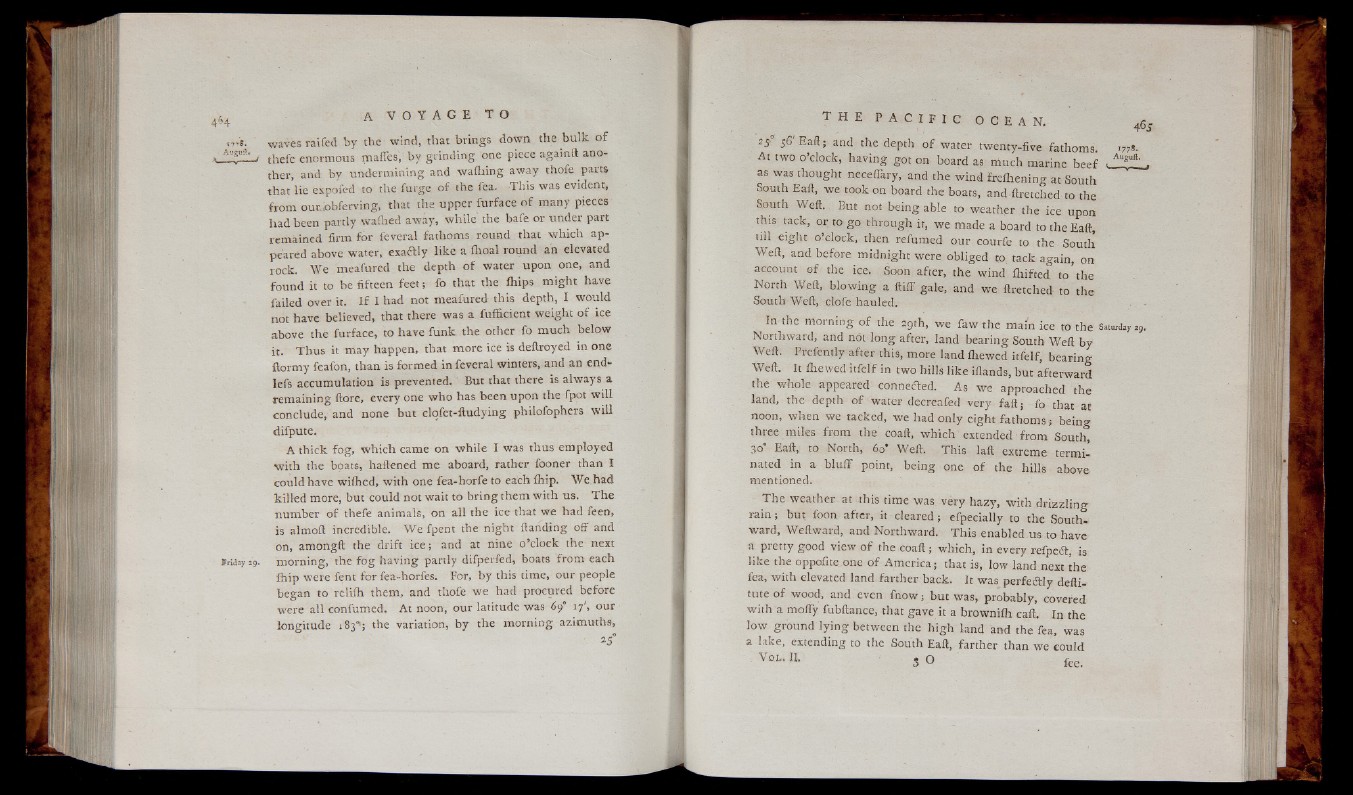
,f|si Waves raifed by the wind, that brings down the b u lk o f
. A'igui-. j enormous mafies,' by grind ing one piece againft another,
and b y undermining and w aihin g away thofe parts
that lie expofed to the furge o f the fea. This was evident,
from our.,obferving, that the upper furface o f many pieces
had been partly wafhed away, while the bafe or under part
remained firm for feveral fathoms round that w hich appeared
above water, exactly lik e a fhoal round an elevated
rock. We meafured the depth o f water upon one, and
found it to be fifteen fe e t; fo that the fhips migh t have
failed over it. I f I had not meafured this depth, I would
not have believed, that there was a fufficient weight o f ice
above the furface, to have fun k the other fo much below
it. T hus it may happen, that more ice is deftroyed in one
ftormy feafon, than is formed in feveral winters, and an end-
lefs accumulation is prevented. But that there is always a
remaining ilore, every one who has been upon the fpot w ill
conclude, and none but clofet-ftudying philofophers will
difpute,
A thick fo g , w hich came on w h ile I was thus employed
w ith the boats, haftened me aboard, rather fooner than I
could have wifhed, with one fea-horfe to each ihip. We had
killed more, but could not wait to bring them w ith us. T he
number o f thefe animals, on all the ice that we had feen,
is almoft incredible. We fpent the night {landing off and
on, amongft the drift ic e ; and at nine o ’clock the next
Friday 29. morning, the fo g having partly difperfed, boats from each
fhip were fent for fea-horfes. For, by this time, our people
began to relifh them, and thofe we had procured before
were all confumed. At noon, our latitude was 69° 17', our
longitude 183°*; the variation, by the morning azimuths,
25°
2 / 5 6 'Eaft; and the depth o f water twenty-five fathoms. >77*-
At two o’clock, ha vin g got on board as much marine b e e f . Ausug'_r
as was thought neceflary, and the wind frefliening at South
South Eaft, we took on board the boats, and ftretched to the
South Weft. But not being able to weather the ice upon
this tack, or to g o through it, we made a board to the Eaft,
till eight o’clock, then refumed our courfe to the South
Weft, and before midnight were obliged to. tack again, on
account o f the ice. Soon after, the wind fluffed to the
North Weft, b low in g a ftiff gale, and we ftretched to the
South Weft, clofe hauled.
In the morning o f the 29th, we faw the main ice to the Saturday a9.
Northward, and not long after, land bearing South Weft by
Weft. Pfefently after this, more land fhewed itfelf, bearing
Weft. It fhewed itfelf in two hills lik e iilands, but afterward
the whole appeared connected. As we approached the
land, the depth o f water decreafed very f a i l ; fo that at
noon, when we tacked, we had only eight fa th om s ; being
three miles from the' coaft, which extended from South,
30* Eaft, to North, 6o‘ Weft. This laft extreme terminated
in a b lu ff point, b eing one o f the hills above,
mentioned.
T h e weather at this time was very ha zy, w ith d r iz z lin g
r a in ; but foon after, it c le a red ; efpecially to the Southward,
Weftward, and Northward. T his enabled us to have
a pretty good view o f the co a ft; which, in every refpeff, is
lik e the oppofitemne o f America; that is, low land next the
fea, with elevated land farther back. It was perfectly defti-
tute o f wood, and even fn ow ; but was, probably, covered
with a moffy fubftance, that gave it a brownifh eaft. In the
low ground ly in g between the h igh land and the fea, was
a lake, extending to the South Eaft, farther than we could
V o l . II, 5 o fee.